If you're in the business-to-business (B2B) world, then you know that B2B content marketing is all the rage. In a world where businesses can be found with the tap of a finger, it’s crucial to stand out from the crowd. That’s where B2B marketing comes in
Creating content is a great way to do that and it can also help you reach new audiences, drive sales, and build your brand.
B2B content marketing is all about creating and distributing relevant, valuable, and consistent content to attract and retain a pre-defined audience — and, ultimately, to drive profitable customer action. It isn’t just about selling your product. It’s about educating your audience so they’ll buy from you when they are ready.
While the concept may seem simple enough, executing a successful B2B content marketing strategy can be challenging. That's why I’ve put together this helpful guide. In it, you'll learn everything you need to know about B2B content marketing.
What Is B2B Content Marketing?
B2B content marketing is aimed at businesses that sell to other businesses. It’s generally more focused on lead generation, driving traffic to your website, and increasing your brand’s authority than B2C (business-to-consumer) marketing. In a nutshell, the goal is to attract, engage, and ultimately convert prospects into customers.
To do this effectively, you need to understand what your audience wants and needs. Then, you need to create content that meets those needs.
Different Types of Content For B2B Marketing
Many different types of content can be used for B2B content marketing. However, not all of them will be equally effective for every business. It is important to choose the right mix of content types that will work best for your particular business and audience.
Some of the best B2B content ideas that you can use include:
1. White Papers
These are in-depth research reports on a specific topic. They are usually used to educate potential customers about a problem or solution.
White papers are an important part of B2B content marketing because they provide valuable information to help businesses make decisions. By creating informative and persuasive white papers, businesses can establish themselves as thought leaders in their industries.
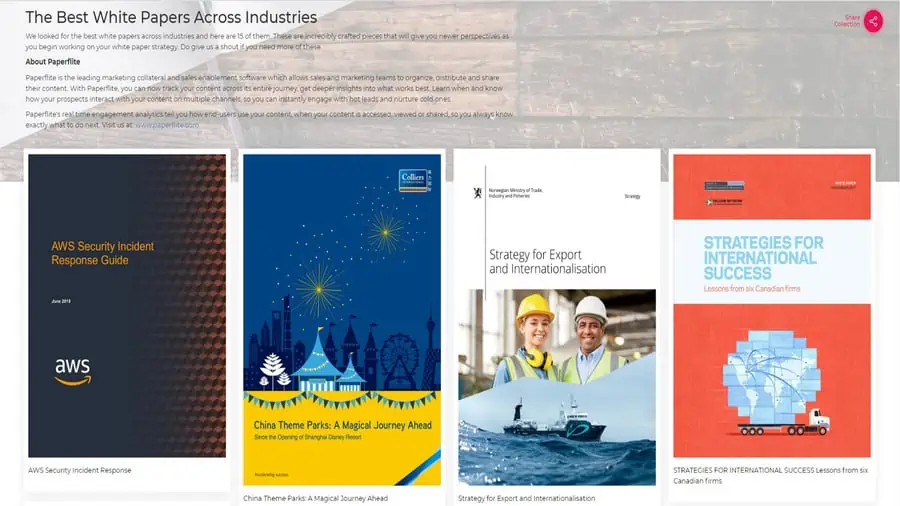
White papers can be used to educate prospects about a company's products or services, explain a complex issue, or make a case for a certain course of action. They are often used as lead generation tools, providing readers with valuable information in exchange for their contact information.
When done well, white papers can be extremely effective at generating leads and converting prospects into customers. However, like any other type of content, they need to be well-written and relevant to the audience to be successful.
2. Blog Posts
The most important thing to keep in mind when writing B2B blog posts is that your content must be helpful and informative. That means creating posts that provide value for your readers, whether that's through educational content, tips and tricks, or insights into your industry.
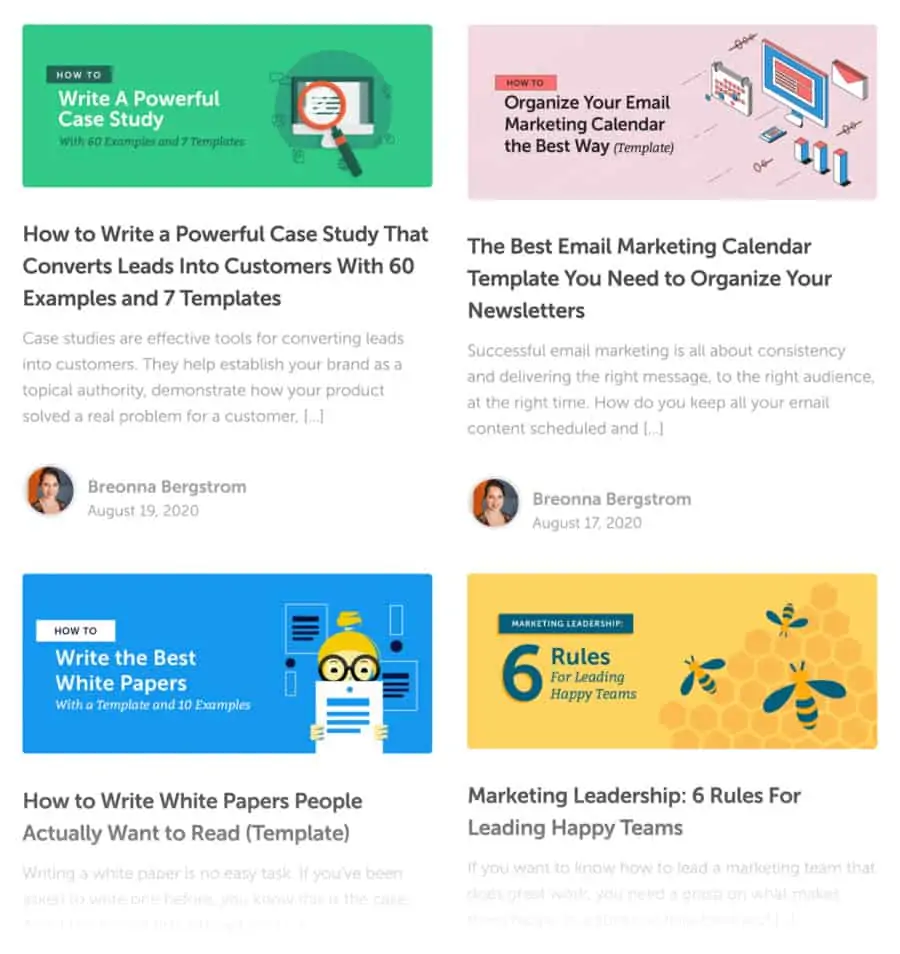
While it's important to have a mix of different types of content on your blog, some of the most popular topics for B2B bloggers include:
- Industry news and trends: Keep your readers up-to-date on the latest industry news and trends with regular blog posts. This type of content helps position you as a thought leader in your field and keeps your readers coming back for more.
- How-to guides and tutorials: Help your readers solve a problem or learn something new with step-by-step guides and tutorials. This type of content is especially popular among B2B audiences, as they're often looking for ways to improve their business processes.
- Product reviews and comparisons: If you sell products, your blog is the perfect place to write in-depth reviews and comparisons. Not only will this help your readers make more informed purchasing decisions, but it will also get ranked on search engines for multiple keywords.
- Expert tips and advice: Share your expert knowledge on a particular topic with blog posts that offer tips and advice. This type of content can be helpful for both novice and experienced readers and helps position you as an authority in your field.
3. Webinars
A webinar is an online seminar. They are an important part of any B2B content marketing campaign. They provide an engaging and interactive way to share information with your audience and can be a great lead generation tool.
When done right, webinars can be a powerful way to connect with your audience and build relationships. They can also be used to drive leads and sales.
However, webinars can also be a lot of work. From planning and promotion to delivery and follow-up, there's a lot that goes into making a successful webinar.
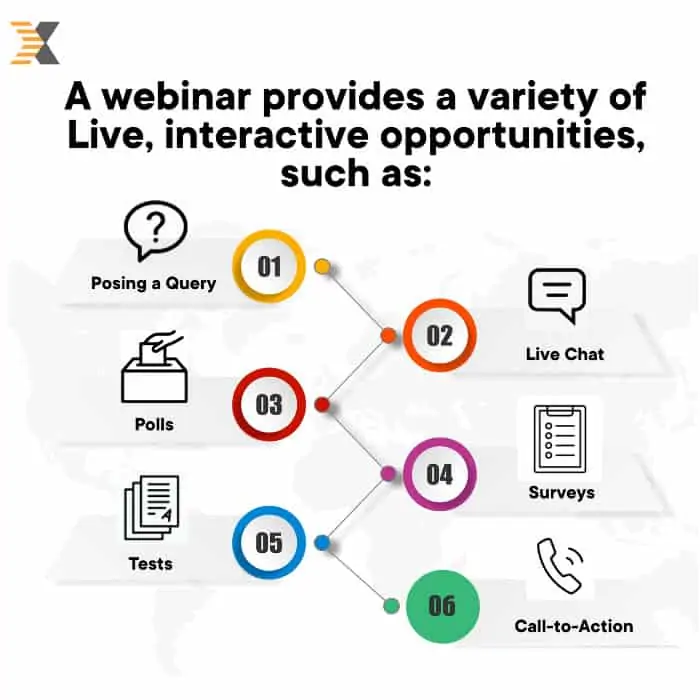
If you want to host webinars that are interactive and secure, you should check out my post on the best webinar hosting websites. With these platforms, you can create automated webinars, create polls, record your sessions, and do more. Plus, they offer integrations with social media apps so you can share it on different social media platforms as well.
4. Case Studies
If you're running a B2B content marketing campaign, case studies can be a valuable addition to your arsenal. Here's why:
For one, they help build trust with your audience. Potential clients are more likely to do business with you if they see that you have happy, satisfied existing customers. Case studies provide that third-party validation.
They also show that you know your stuff. A well-written case study demonstrates your expertise and ability to solve problems for your clients. This can help set you apart from the competition and attract new business.
Finally, case studies are simply interesting reading material. They offer a behind-the-scenes look at how businesses actually use your product or services, and people enjoy reading about real-world success stories.
So if you're not already using them, be sure to add case studies to your next B2B content marketing campaign. They just might be the key to winning over new customers.
5. Ebooks
An ebook is a long-form piece of content that can be downloaded and read on a device like a Kindle or iPad. They are usually used to provide more in-depth information than a blog post or white paper.
Ebooks are a great way to get your message across to potential customers and clients. By providing high-quality, informative content in an ebook format, you can show your audience that you're an expert in your field and that you're able to provide them with valuable information.
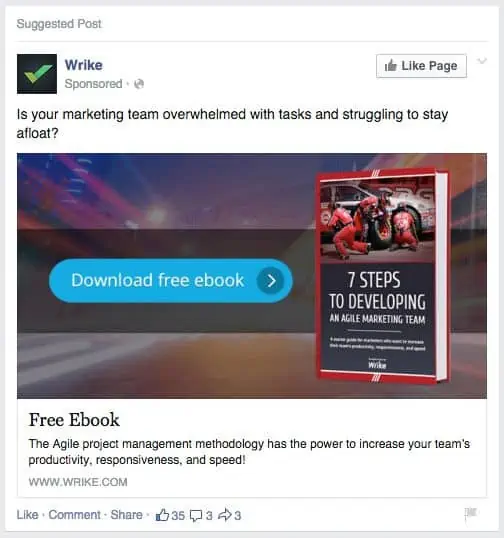
Ebooks can also be used as a lead generation tool. By offering an ebook as a free download, you can entice potential customers and clients to sign up for your email list or opt-in to your newsletter. This way, you can continue marketing to them even after they've left your website.
One of the great things about ebooks is that they're easily shareable. That means they can be a great asset for your B2B content marketing campaigns.
When you create an ebook, you're not just creating content – you're creating a valuable resource that can be shared with others. And when others share your ebook, it helps to promote your brand and build awareness for your business.
6. Infographics
If you're looking for a way to add some pizzazz to your B2B content marketing campaigns, consider using infographics.
These very visual pieces can be great for making complex information more digestible and engaging for your audience. The visual elements and the concise format ensure that your audience doesn't get overwhelmed.
And when you include data in an infographic, you're effectively lending credibility to your content. After all, numbers don't lie. So if you can back up your claims with hard data, your audience is more likely to trust what you have to say.

If you want to improve your brand visibility and reach a wider audience, infographics can be a useful tool in your arsenal. Thanks to social media channels, it's easier than ever to share content with a wide audience.
And infographics are particularly well-suited for sharing since they're visually appealing and easy to understand at a glance. If your infographic is informative and well-designed, there's a good chance it will be shared by your target audience.
7. Slideshows
We all know that slideshows are a vital part of any presentation. They help us to focus our audience's attention on key points and make complex information more digestible. But did you know that they can also be hugely beneficial for your B2B content marketing campaigns?
Let's face it, most people are visual learners. By using slideshows, you can tap into this and make your content more engaging and memorable.
What’s more, slideshows can be used in a variety of ways, from educational pieces to sales presentations. This makes them incredibly versatile and suitable for a wide range of content marketing campaigns.
There are all sorts of different types of slideshows that you can create for your B2B content marketing campaigns. You can use them to showcase your products or services, share helpful tips and tricks, or even tell a story.
Whatever type of slideshow you decide to create, make sure that it is engaging and informative. Your goal is to capture your audience's attention, keep them engaged throughout the entire presentation, and make them want to share it with others.
8. Videos
Videos are a great way to engage your audience and build relationships. They can be used to educate, entertain, or both.
You can go the traditional route and make a commercial, or you can get creative and produce an interactive video experience. You can also create explainer videos, product demonstrations, customer testimonials, or even just fun little clips that show off your company culture.
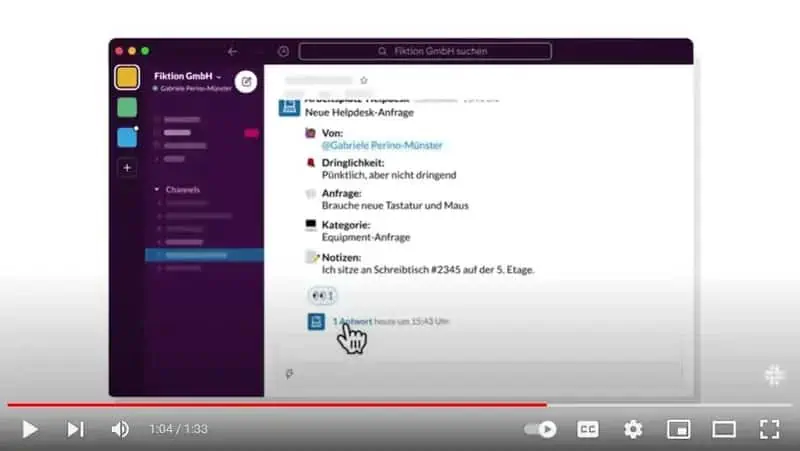
No matter what type of video you decide to create, the important thing is that it is engaging and informative. It should give viewers a taste of what your company or product is all about, and leave them wanting more.
Creating videos for your B2B content marketing campaigns can be a great way to reach a larger audience and promote your business.
If you're not sure where to start, consider hiring a video production company to help you create high-quality videos that will engage your target audience. Or if you’re on a limited budget, consider checking out these easy-to-use video editing tools to make your B2B videos stand out.
9. Podcasts
A podcast is an audio show that can be downloaded and listened to on a computer or mobile device. They are often used to share expert interviews or provide commentary on current events.
Podcasts can be a great addition to your B2B content marketing strategy. They provide an engaging and interactive format that can help you connect with your audience. Plus, they're relatively easy to produce, so you can get started without a huge investment of time or money.
What’s more, podcasts are easy to consume on the go. This makes them perfect for busy professionals who want to stay informed while they're commuting or working out. They may not have the time to read lengthy blog posts, but audio, while they are doing other activities, can certainly fit into their schedule.
In addition to this, podcasts are more personal than other content types. Because podcasts are usually conversational in nature, they can create a strong connection between the host and the listener. This can make your brand feel more relatable and trustworthy.
So there you have it! These are just a few examples of B2B content marketing in action. Get creative and see what types of content you can create to help your business succeed.
Importance of B2B Content Marketing
There's no question that content marketing is important for businesses of all sizes. But what about B2B companies? Why is B2B content marketing so vital, and how can you make sure you're doing it right?
For starters, it's worth noting that the vast majority of B2B buyers (94%) say that online content has a moderate to major impact on their purchase decisions. In other words, if your company isn't creating compelling content, you're likely missing out on valuable leads and sales.
But why is B2B content marketing so effective? To understand that, it's helpful to look at the buyer's journey, which consists of three main stages: awareness, consideration, and decision. The last two stages (loyalty and advocacy) are to ensure that you have repeat customers.
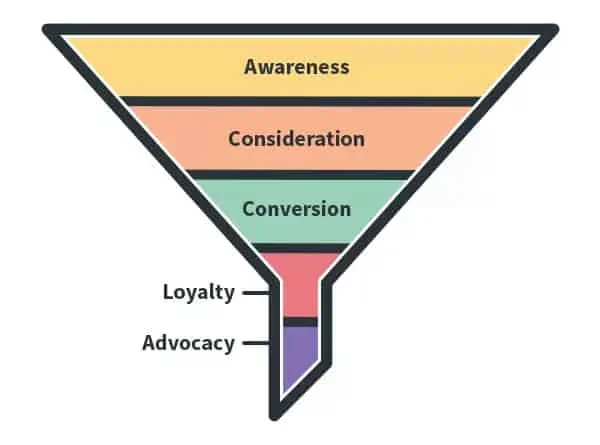
At the awareness stage, your buyer is just beginning to realize that they have a problem or need that your product or service can address. At this point, they're not yet ready to make a purchase, but they are starting to do some research.
This is where B2B content marketing comes in. By creating helpful, informative content (such as blog posts, infographics, ebooks, etc.), you can introduce your company and its solutions to potential buyers and begin to build trust.
As buyers move into the consideration stage, they'll be looking for more in-depth information about their options. Here, case studies, white papers, and other forms of long-form content can be very helpful for convincing buyers that your company is the right choice.
Finally, at the decision stage, buyers are ready to choose a solution. At this point, they'll be looking for things like product demos, free trials, and pricing information. By providing this type of content, you can seal the deal and earn a new customer.
For the last two stages, a mix of different types of content along with discount deals can work wonders.
So there you have it: three good reasons to make B2B content marketing a priority for your business. Now it's time to start creating some compelling content of your own!
B2B Content Marketing vs B2C Content Marketing
On the surface, it may seem like B2B content marketing is just a mirror of B2C marketing. But if you look closely, you’ll realize that both B2B and B2C campaigns need to be designed differently.
The main reason for this is that the customer journey is different for B2B and B2C customers. In the business-to-business (B2B) world, the customer journey is often more complex.
In the next section, I will take a look at all the other major differences between B2B and B2C marketing approaches.

Multiple Decision-Makers Are Involved in B2B Campaigns
One of the main reasons for this is that there are usually multiple decision-makers involved in the purchase process. For instance, you may be talking about your product or service to someone from the operations team.
Even if they are convinced about buying your product or service, they may need approval from department heads, vice presidents, or CEOs. In nutshell, all the decision-makers must be convinced if you want them to make a purchase.
A bad purchase can have serious consequences for the business, so buyers are generally more cautious and do more research before making a purchase.
Higher Price Points For B2B Products/Services
Businesses need to carefully consider their purchase decisions, as they are usually investing more money into them. The price points for B2B products are typically higher than for B2C products.
Since the stakes are higher, it is understandable that the decision-makers want to understand all the features and benefits of your product or service before they commit. They may even want free trials or multiple demos to get a clear idea of what you have to offer. Again, this leads to a longer sales cycle.
Buyers Have Better Clarity of Needs in B2B Settings
Buyers in a B2B setting are generally more informed and sophisticated than buyers in a B2C setting. There is a lot at stake so they know exactly what they are looking for.
This means that they are more likely to know what they want and need, and they are less likely to be swayed by marketing messages or sales pitches.
If you are selling to B2B buyers, it is important to keep these factors in mind and to be prepared for a longer sales cycle. By understanding the needs of your target market, you can better tailor your marketing and sales efforts to meet their expectations.
Elements of a Great B2B Content Marketing Strategy
Creating a great content marketing strategy for your business can seem overwhelming. There are so many things you could write about, and you’re not sure where to start.
After all, what is a content marketing strategy? What factors should you consider when developing one for your company?
A great B2B content marketing strategy is a detailed roadmap that guides your company’s content marketing efforts. It outlines your strategy, your goals, and the channels through which you’ll achieve them.
Your B2B content marketing strategy will likely contain the same key components as your overall marketing strategy:
- Objectives: What results do you hope to achieve through this content marketing effort?
- Goals: What do you want to achieve with your content marketing efforts? More website visitors? More leads? More sales?
- Audience: Who are you trying to reach with your content? What kinds of information do they need?
- Buyer Personas: Once you've defined your audience, create buyer personas to help you better understand their needs and how your content can help them. You can find multiple templates that will help you create B2B personas.
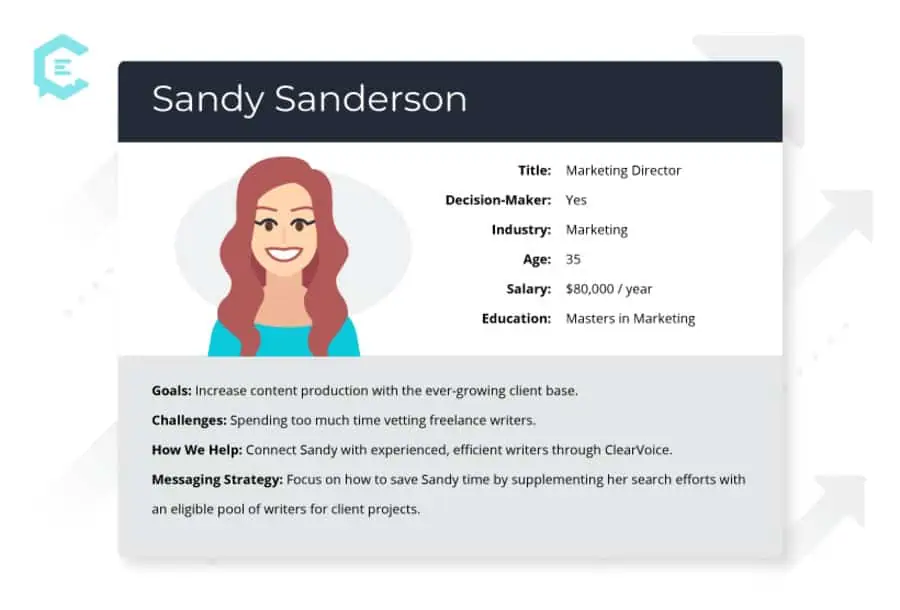
- Keywords: What terms are your audience searching for when they're looking for information related to your business? Use keyword research tools like Google AdWords Keyword Planner to find out.
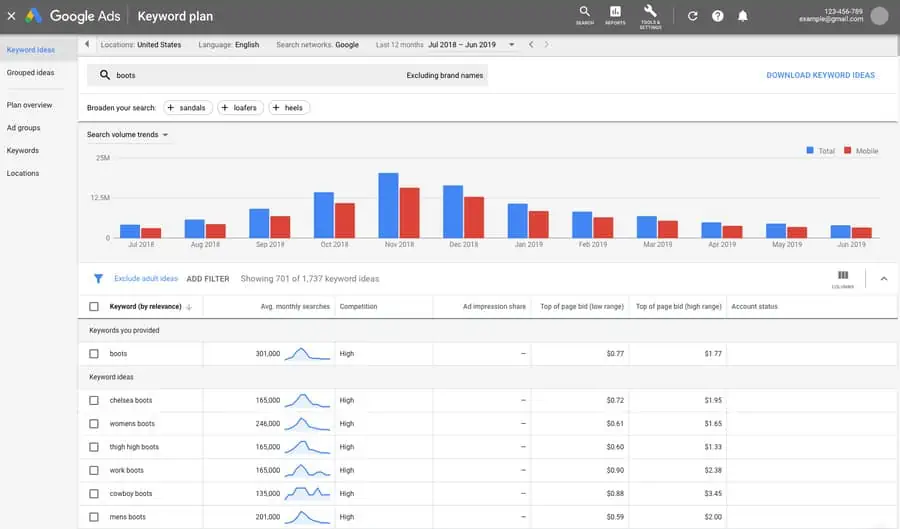
- Topics: What are you going to write about? What kinds of content will you create? Once you have the answers to these questions, map out when and where you'll publish it using an editorial calendar. This will help you stay organized and on track.
- Distribution: How will you reach these audiences? Will you promote it via email campaigns, social media campaigns, or other channels? What are some best practices you can follow?
- Measurements: What metrics will you measure to see how your content marketing efforts are going?
A B2B content marketing strategy is about more than just building a few articles and slapping some keywords in. Your B2B content marketing strategy should be the foundation on which your efforts are built. It should be the driving force behind all your content marketing efforts.
It’s crucial to have a great B2B content marketing strategy because it helps you avoid many of the pitfalls that can occur when it comes to B2B content marketing.
With a well-thought-out strategy in place, you can avoid wasting time and resources on content that isn’t going to be successful. You can avoid putting your resources into content that isn’t going to draw in a large audience.
A great B2B content marketing strategy will also allow you to build upon your efforts as you continue to grow your business. With a solid plan in place from the start, you can use this strategy to further your goals and overall success.
One important tip for creating a successful B2B content marketing strategy is to focus on quality over quantity. It's better to publish a few pieces of truly great content than it is to churn out a lot of mediocre stuff.
So take the time to create something really useful and exciting, and promote it accordingly. Your audience will thank you for it! another tip is to make sure you are constantly creating new content.
How to Do B2B Content Marketing Right
The common misconception about B2B marketing is that it's all about selling products and services to other businesses. However, effective BtoB content marketing is actually about creating valuable content that helps your target audience do their jobs better.
As you develop your content marketing strategy, it's important to keep in mind where your target audience is in their purchase journey. Whether they are just starting to research a problem or they are ready to buy, your content should be tailored to meet them where they are.
If you're not sure how to determine what stage of the purchase journey your audience is in, don't worry. We've put together a quick guide to help you get started.
The first step is to understand the different stages of the purchase journey. Let’s understand the concerts of buyers at each stage of the funnel.
1. Awareness Stage
In this stage, potential buyers become aware that they have a problem or need that can be addressed by your product or service. They are just beginning their research and are not yet ready to buy.
One of the most important things to keep in mind when creating content for the awareness stage is that buyers are still getting familiar with their problem or need. They may not even be sure what they're looking for yet. So, your content should be educational and informative, without being too sales-y.
Buyers in the awareness stage may not be ready to commit to a long white paper or video, but they might be interested in a quick blog post, video, or infographic. By offering a variety of content types, you’ll appeal to buyers at different stages of their research.
All of these pieces can help educate buyers about their problem or need, and position your company as a thought leader in the industry.
Also, make sure your content is easy to find and access. Buyers in the awareness stage are just beginning their research, so they may not be familiar with your brand or website.
Make it easy for them to find the information they need by including links to your content on every page of your website and in every email you send.
It’s also a good idea to use keyword-rich titles and descriptions. When buyers are searching for information online, they use keywords. Help them find your content by using those same keywords in your titles and descriptions.
2. Consideration or Evaluation Stage
In this stage, potential buyers are actively researching their options and evaluating which product or service is best for them. They are comparing your offering to those of your competitors.
In this stage, buyers are already aware of their needs and they are actively searching for information about potential solutions.
Your goal at this stage is to educate them about your product or service and help them understand how it can meet their needs. You also need to showcase what your USP is compared to other similar solutions in the market.
Your content should be focused on providing helpful information that will help your buyers make an informed decision. You should avoid hard selling or trying to close the sale at this stage.
Instead, you should focus on building trust and rapport with your buyer so that they will consider doing business with you when they are ready to make a purchase.
Here are some types of B2B content that you should provide users who are in the consideration stage of their buying process:
- How-to guides: They help your buyer understand how to use your product or service to achieve their desired outcome.
- Product comparisons: This type of content provides an objective look at how your offering stacks up against the competition.
- Case studies: This content show potential buyers how other companies have used your product or service to achieve success.
- Industry reports: These reports give buyers the big-picture view of trends and challenges in their sector.
3. Decision Stage
By the time your prospects reach the decision-making stage, they have probably seen your brand pop up in several places across the internet. They might’ve even visited your website or followed you on social media.
Now that they’re familiar with who you are, it’s time to start providing them with content that will help them make a decision. Here are some ideas:
- Customer stories: There’s nothing more powerful than hearing from a satisfied customer. Customer stories can come in the form of blog posts, social media posts, and videos.
- Product demos: If you have a product or service that requires some explanation, then a demo video is the way to go. You can show prospects how your product works and what sets it apart from the competition.
7 Strategies to Create and Promote B2B Content More Effectively
In today’s world, brands have a greater opportunity than ever to stand out from their competitors by creating content that is relevant, useful, and engaging. But promoting your brand-specific content can be challenging.
After all, there are many ways to promote your company’s blog or website. Here are seven strategies to help you promote B2B content effectively.
1. Use Targeted Lead Capture Forms
When it comes to B2B content marketing, one size definitely does not fit all. To effectively reach and resonate with your target audience, you need to create content that is specifically tailored to their needs and interests. And one of the best ways to do this is through the use of targeted lead capture forms.
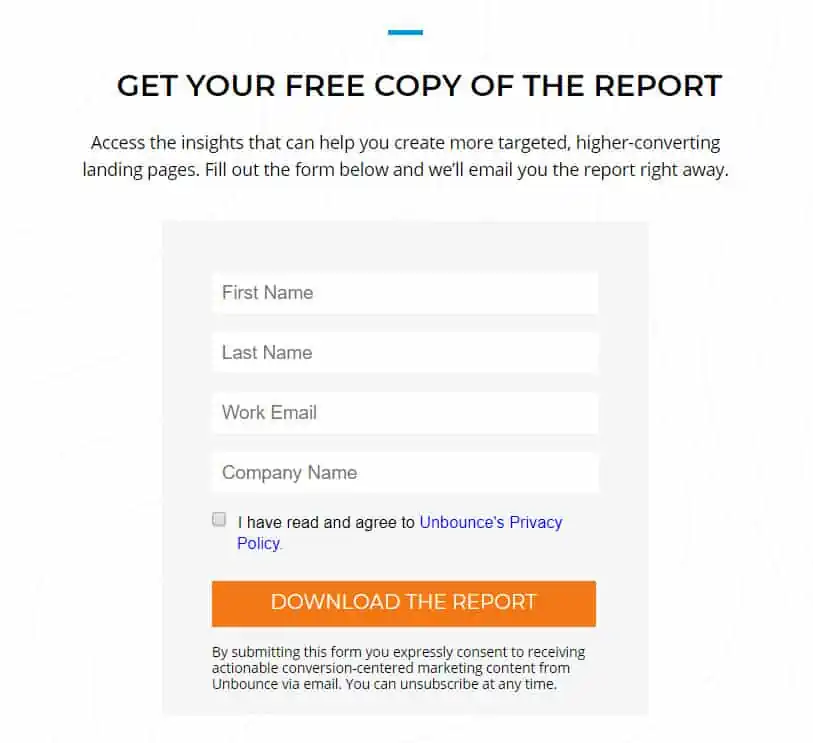
Lead capture forms are essentially online forms that allow you to gather information about your leads, such as their name, email addresses, job titles, and company names.
By using a targeted lead capture form on your website or blog, you can ensure that you're only collecting information from leads who are actually interested in what you have to say.
This helps to save time and resources by weeding out those who are not a good fit for your products or services.
In addition, targeted lead capture forms also allow you to segment your leads so that you can send them more targeted content down the line.
For example, if you know that a particular lead is interested in product A, you can make sure to send them information about product A in the future. This helps to further nurture the relationship and keep your brand top of mind.
2. Automate Your Email Marketing Campaigns
As a B2B marketer, you know that email is still one of the most effective channels for content distribution. But manually sending out emails to your list can be time-consuming and frustrating, especially if you have a large list.
That's why automating your email campaigns can be such a lifesaver. With automation, you can set up your emails in advance and then sit back and relax while they go out to your subscribers on their own. Not only will this save you time, but it can also help ensure that your messages are always going out on schedule.
Plus, automated emails can be highly personalized, which can help improve click-through rates and conversions. So if you're not already using email automation for your B2B content marketing, now is the time to start.
3. Pay Attention to User Intent
User intent should be at the forefront of any B2B marketer’s mind when creating content. After all, if your target audience can’t find what they’re looking for, or worse – you show them something that isn’t relevant to their needs – you’ve lost them
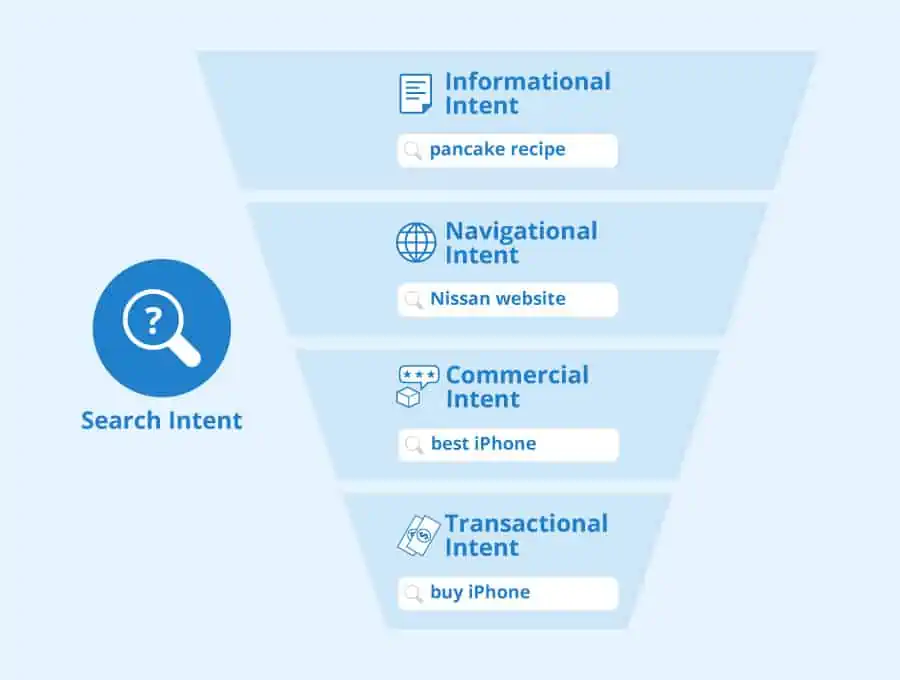
There are a few different types of user intent to keep in mind. They are the same for B2B and B2C users.
- Informational: The user is looking for information on a given topic. For example, they may type in “How to improve content marketing” into Google.
- Navigational: The user is looking for a specific website or page. For example, they may type in “Company XYZ blog” into Google.
- Commercial: The user is looking for a specific product or service. The intent may to find out reviews or compare prices. For example, a user may type, “XX product reviews.”
- Transactional: The user is looking to purchase a product or service. For example, they may type in “Company XYZ pricing” into Google.
If you want your content to be successful, you need to make sure it aligns with the user’s intent. Otherwise, you run the risk of turning potential customers away.
4. Leverage Remarketing
Remarketing can be an extremely effective tool for B2B marketers. By targeting individuals who have already shown an interest in your product or service, you can more effectively market your content to them and improve your overall content strategy.
Here are a few tips on how to leverage remarketing to improve your content strategy:
First, make sure that your website is set up for remarketing. This means adding the necessary code to your site so that you can collect data on visitors and track their behavior. Once you have this setup, you can start building out targeted audiences based on their interactions with your site.
Next, create compelling ads and offers that will appeal to your target audience. Remember, these individuals have already shown an interest in what you have to offer, so your ads and offers should be highly relevant to their needs.
Finally, make sure to track your results so that you can continually optimize your remarketing efforts. By understanding what is working and what isn't, you can make adjustments to your strategy as needed and ensure that you are getting the most out of this powerful marketing tool.
5. Make the Most of LinkedIn
LinkedIn is a powerful platform for B2B marketers, but it takes more than just having a profile to make it work for your business.
You need to put in the effort to develop relationships, engage with potential customers, and generate leads if you want to see results. But when you do, LinkedIn can be an incredibly effective tool for growing your business.
Here are some tips on how to make the most of LinkedIn marketing:
- Develop a strong company profile. Include information about your company's history, products and services, and mission statement. Be sure to include keywords that will help potential customers find you.
- Build relationships with other businesses in your industry. Connect with them on LinkedIn and share their content. This will help you build credibility and authority within your industry.
- Engage with your target audience. Join relevant content groups and participate in discussions. Share valuable insights and perspectives that will help position you as a thought leader in your field.
- Generate leads with targeted content offers. Use LinkedIn's lead generation tools to create content offers that will resonate with your target audience.
6. Add FAQs
If you're a B2B marketer, there's a good chance you've been asked a lot of questions about your product or service. You may have even been asked the same question multiple times. While it can be frustrating to keep answering the same questions, it's important to remember that your customers are just trying to learn more about what you offer.
One way to help your customers (and save yourself some time) is to create an FAQ page on your website. This can be a simple page that addresses common questions and provides brief answers.
You can also link to other resources, such as customer support or tutorials if needed. In fact, you could have a dedicated FAQ section in each blog post too.
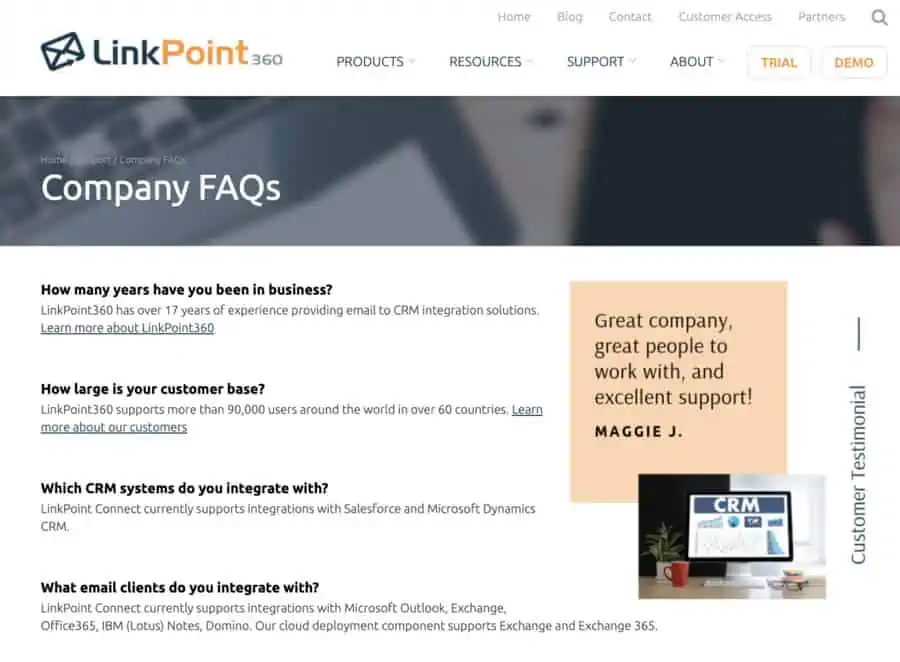
An FAQ page can be a valuable resource for both you and your customers. By taking the time to answer common questions, you can provide your customers with the information they need and make their experience with your company more positive. Plus, you'll save time in the long run by having a go-to resource for answers.
7. Use Video Marketing
Video marketing is not a new concept, but it is often overlooked by B2B marketers. There are many reasons why video should be a part of your marketing mix, but here are three of the most important:
First, video is an engaging medium that can capture attention and hold it for extended periods. A well-produced video can tell a story in a way that static images and text simply cannot match.
Second, video content is a great way to build trust and credibility with your audience. When potential customers see you and your team on camera, they get a sense of who you are and what you stand for. Such content creation can go a long way towards building the kind of relationships that lead to sales.
Finally, video is an extremely versatile medium that can be used in a variety of ways. You can use it for product demonstrations, customer testimonials, educational content, and much more. No matter what your marketing goals are, there’s a good chance that video can help you achieve them.
Ultimately, the best way to promote your B2B content is to create engaging content that people want to consume. This can be a challenging task, but it’s also a worthwhile investment that can help your business stand out from the competition.
8 Examples of Great B2B Content Marketing Campaigns
In this section, I want to take a step back and look at some examples of the best B2B content marketing campaigns from some of the world’s top brands. These should give you a good idea of what’s possible when you put your thinking cap on and get creative with your content strategy.
1. Blog Posts from Buffer
Boring, dull content will never capture (and keep) your audience's attention. If you want to stand out in the ever-growing sea of content, you need to create something worth reading—something that educates, informs, and entertains. That's where educational content comes in.
Creating educational content may seem like a lot of work, but it's worth it. If you’re looking for inspiration to create high-quality B2B content, check out the blog section on Buffer. They have detailed guides that outline pain points and offer credible solutions.
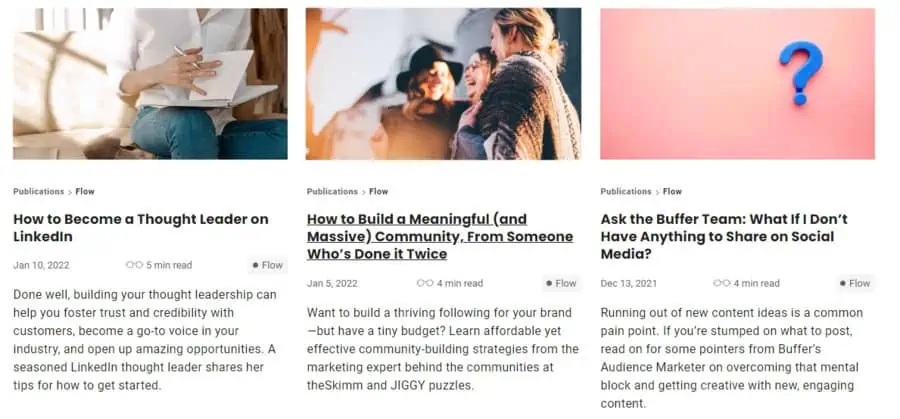
What You Can Learn From This
By creating educational content, B2B marketers can build trust and credibility with potential customers. When customers feel like they can trust a company, they are more likely to do business with that company.
2. Infographics from Toggl
Boring, static text is a thing of the past. In today's age of social media and constant connectedness, people are looking for more engaging B2B content that is easy to consume.
This is where infographics come in.
If you have a lot of data that you need to present in a way that is both accessible and visually appealing, an infographic can be a great solution. Check out how Toggl makes a serious topic like software development seem super interesting with eye-catching visuals.

What You Can Learn From This
With a bit of creativity and good design skills, you can make even the most boring, mundane topics fun with infographics.
In addition to being informative, Toggl's infographics are also very shareable. This helps to amplify their reach and ensure that their content is seen by as many people as possible.
3. Microsoft’s Explainer Video
In a world where buyers are overwhelmed with choices and information, it's more important than ever for B2B marketers to find ways to break through the clutter and explain their products and services in a way that is both clear and compelling. And there's no better way to do that than with an explainer video.
If you’re looking to create your own explainer video, check out Microsoft’s explainer video on how their Cloud system functions.
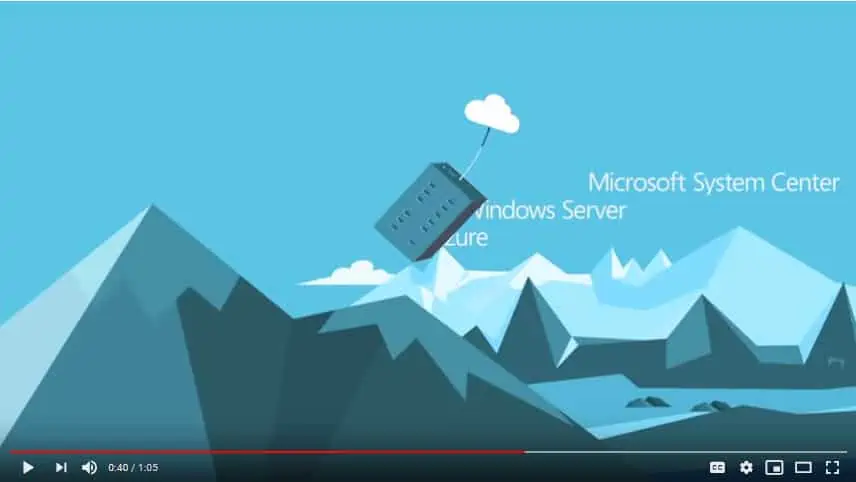
What You Can Learn From This
You can create a short, animated video that tells the story of your product or service in a way that is easy to understand and digest. In just a few minutes, you can convey all of the key information that potential customers need to know about what you're offering.
4. TGIM From Shopify
Podcasts are a great way to reach out to potential customers and connect with them on a personal level. They offer an intimate setting that allows you to share your story and build trust with your audience.
Podcasts offer busy professionals a convenient way to consume content while they're driving, working out, or doing chores around the house. And because podcasts are usually only 20-30 minutes long, they're the perfect length for busy people who want to learn something new but don't have a lot of time to spare.
They can also show off your expertise and build authority in your industry. By producing your own podcast, you can control the narrative and position yourself as a thought leader. And if you produce high-quality content, you can attract new listeners and grow your following.
Take inspiration from TGIM from Shopify. The company is hoping to change the way Americans feel about Mondays with their new podcast, Thank God It's Monday (or TGIM).
Shopify's podcasts cover success stories of driven entrepreneurs, and they're designed to get Shopify's audience of innovators pumped for the week ahead.
TGIM features interviews with a slew of high-profile business executives and entrepreneurs, including marketing gurus Seth Godin, Gary Vaynerchuk, and Hootsuite CEO Ryan Holmes. They discuss everything from business growth to the latest marketing trends.
What You Can Learn From This
Invite industry experts on your podcast so that you can know what others in the industry are up to. At the same time, it gives you an opportunity to reach out to their audience and grow your online presence. In fact, you can even create co-branded podcasts with others in the same industry for extra clout and reach.
5. Ebooks From SEMrush
As a B2B marketer, the type of ebooks you produce should be based on what your target audience is looking for. If they are seeking information on trends in your industry, then an ebook discussing these trends would be beneficial.
However, if your target audience is more interested in tips and tricks from experts in your field, then an ebook with this focus would be a better option.
No matter what type of ebook you decide to create, make sure it is well-researched and provides value to your reader. By doing so, you will increase the chances that your ebook will be successful in generating leads for your business.
If you’re looking for inspiration, check out Semrush’s website. They have an entire section dedicated to different ebooks that they have. In fact, they also have a free ebook template and a press release template that can help other B2B marketers.
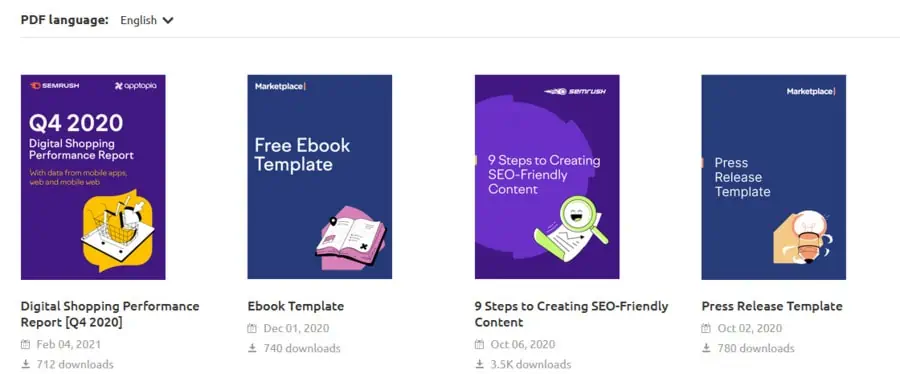
What You Can Learn From This
One of the best things about ebooks is that they can be very targeted. This means that you can produce an ebook that is relevant to a particular pain point or challenge your target market is facing.
This is something that biz marketers can learn from Semrush's content marketing tactic of producing ebooks. By creating ebooks targeted at solving specific problems, Semrush has been able to create content that resonates with its audience and drives conversions.
6. Cisco’s Graphic Novels
Case studies are an excellent way to show potential customers how your product or service has helped others in a similar situation. They can also be used to build trust and credibility with potential customers.
They directly demonstrate how you have solved a problem and made a difference. They can make a world of difference when converting prospects into paying customers.
But when you're reading a case study, it's easy to get bogged down in the details. All of the numbers and statistics can be overwhelming, and it's easy to lose sight of the big picture.
That's why it's important to remember that case studies are stories. They're designed to glimpse how a company or individual has used technology to overcome a challenge. And like any good story, they should have a beginning, middle, and end.
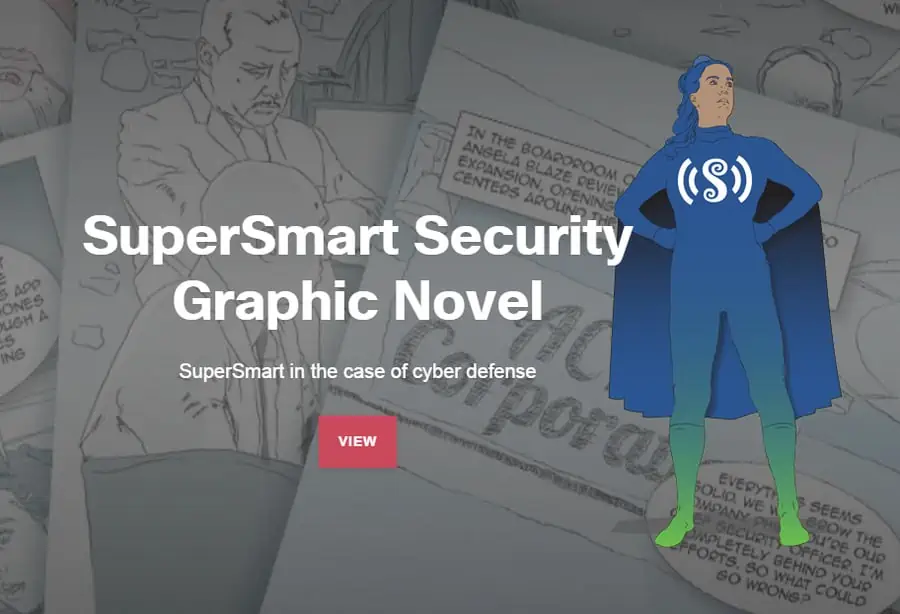
Cisco made sure that dry content was made interesting with a graphic novel. Cisco created a graphic novel to communicate the message that security is constantly evolving and that there is a need for stronger security, without coming across as alarmist.
In this eight-page ebook, they showed how their company can help you tackle security loopholes and elevate your cyber security.
What You Can Learn From This
Cisco's comic book isn't only informative, but it's also creative and unique. The comic book does an excellent job of breaking down complex tech concepts for those who are outside of the tech industry. Consequently, readers are more likely to share this easily digested document with others.
7. Active Campaign’s Webinars
Webinars are a fantastic way to generate leads and build relationships with potential customers. They offer an engaging, interactive format that allows you to connect with your audience in a deeper way than other forms of content marketing.
Webinars are versatile. You can use them to introduce new products or services, host expert panels, or deliver educational content. No matter what your goals are, there's a way to use webinars to achieve them.
Want some inspiration?
Check out how Active Campaign introduced new product updates via a series of webinars. This type of onboarding can ensure that customers know how to make the most of your B2B product or services.
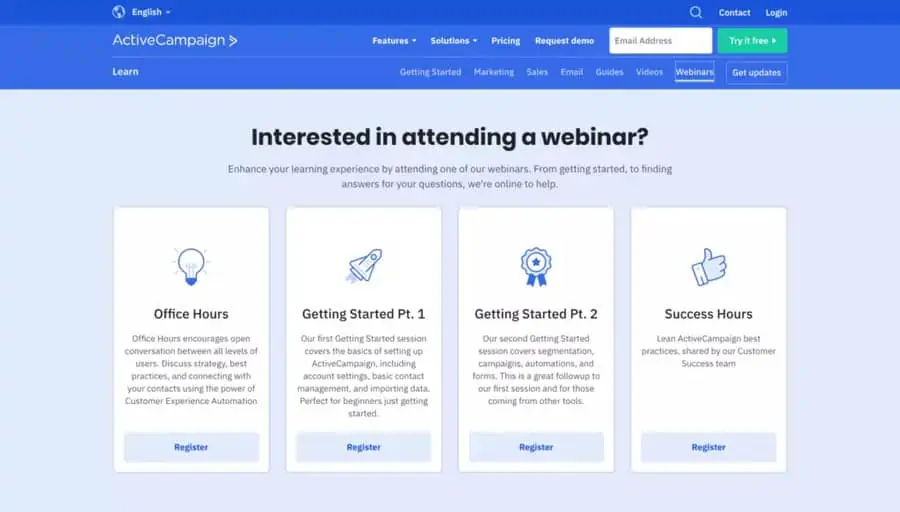
What You Can Learn From This
Active Campaign’s webinars offer a personal touch that can help build relationships with new customers. When you host a live event, you have the opportunity to interact with your audience in real-time and answer any questions they may have. This back-and-forth interaction builds trust and rapport between you and your new customers.
8. HubSpot’s Memes
While you may not think of memes as being particularly “professional”, they can actually be a great way to reach your target market. B2B marketers can use memes to show that they’re keeping up with current trends, but more importantly, that they understand their audience.
Take inspiration from the meme below published by HubSpot. It’s a generic meme that shows what it is like to work in sales. It’s relatable, on-trend, and funny!
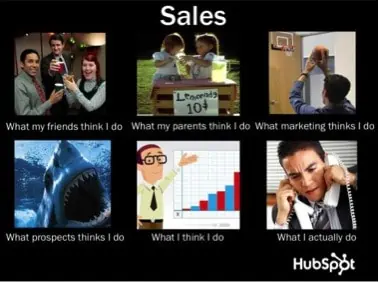
What You Can Learn From This
Humor is often viewed as a tool to be used sparingly in business settings, but that doesn't have to be the case. In fact, humor can be a powerful marketing tool for B2B marketers – if it's used correctly.
When used correctly, humor can help break the ice, make your brand more relatable, and even make complex topics more digestible. Of course, there is such a thing as using too much humor or using it in the wrong way. But as long as you use good judgment and keep your audience in mind, you'll be able to use humor effectively in your marketing campaigns.
FAQs
1. How do you use content marketing for B2B companies?
Content marketing can be used in several ways to support B2B marketing objectives. Here are four common uses:
– To drive awareness of a company, its products, or its services
– To generate leads
– To build relationships and engage customers
– To support sales efforts
2. How do you create B2B content?
To create B2B content, you need to understand what your audience is looking for. Take a closer look at their purchase journey and understand their needs. Tailor your content such that is relevant to them while also being engaging and informative.
3. How do you create a content strategy for B2B marketing?
Here are some steps to create an effective B2B content marketing strategy:
– Define your goals.
– Understand your audience.
– Identify your topics.
– Create your content.
– Distribute your content via multiple channels.
– Analyze your campaign results.
4. What kind of content can B2B companies create?
B2B companies can create various different types of content including podcasts, blog posts, white papers, webinars, case studies, ebooks, infographics, slideshows, and podcasts.
5. What are some effective strategies to promote B2B content?
Here are some ideas to promote your B2B content:
– Use targeted lead capture forms.
– Use email automation.
– Leverage remarketing.
– Use video marketing.
Ready to Develop Your Own B2B Content Marketing Strategy?
B2B content marketing is no longer optional. With consumers getting warier and warier of marketing strategies as a whole, it’s more important than ever to be able to not only show your products but also explain them succinctly and at a level that will help persuade.
To do this, you need B2B content marketing strategies that are strategic, focused, measurable, and repeatable to get the most out of your efforts.
This means creating a roadmap that focuses on research, topics, frequency, and timing of the content release, followed by a prioritization of topics and an editorial calendar that incorporates a mix of online and offline content.
Use the pointers mentioned in this article to come up with an effective B2B content marketing strategy. Check out the examples mentioned closely for some inspiration.
Do you have any questions about developing a B2B content marketing strategy? Please feel free to mention them in the comments section.


Related Articles
22 Useful Content Promotion Platforms and Tools
21 Awesome Ecommerce Content Marketing Examples for 2024
7 B2B Content Marketing Tactics You Need to Start Using Today
Short Form Vs. Long Form Content: Which is Better?
21 Best Content Writing Tools to Help You Become a Better Writer
11 Best Grammarly Alternatives That a Smart Writer Needs to Know